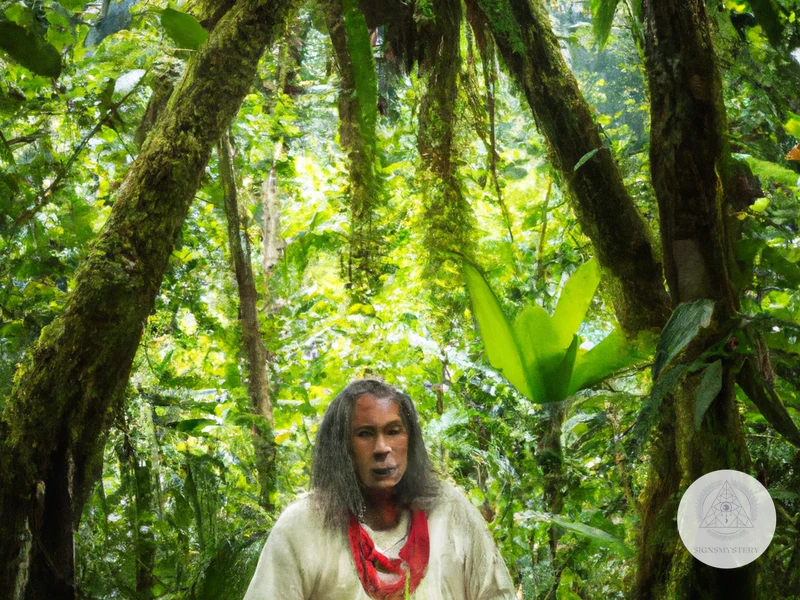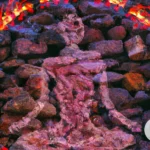Introduction

Shamanism is a practice that dates back to ancient times and is still prevalent in many cultures today. It involves a shaman, or spiritual guide, who uses his or her connection to the spiritual world to heal and provide guidance to the community. There are different types of shamans with unique practices, and this article aims to explore each in detail. From Traditional/Indigenous Shamans found in various continents around the world, to the more modern Neo-Shamans, Urban Shamans, and Mystical Shamans, each has something unique to offer. We will also look at the practices that differentiate each type of shaman such as shamanic journeys, drumming and singing, ceremonies and rituals, and the use of plant medicine. Let’s dive deeper into understanding the fascinating world of shamans and their practices.
Understanding Shamanism
Shamanism is a spiritual practice rooted in ancient traditions that dates back thousands of years. At its core, Shamanism involves practitioners – *shamans*, who act as a bridge between the physical world and spiritual world. In Shamanism, the universe is viewed as an interconnected web of life, where everything is alive and has a spirit.
Shamanism is found in diverse cultures worldwide, including in Asia, Europe, Africa, South and North America, and Australia. As such, it is not surprising that Shamanism has many interpretations and practices, each with their own techniques and methods.
Shamanism is often characterized by its use of altered states of consciousness, often achieved through drumming, chanting, or the use of plant medicine. These altered states of consciousness are said to facilitate communication with the spirit world, where the shaman seeks guidance, healing, or knowledge.
There are several types of shamans, including traditional/indigenous shamans, neo-shamans, urban shamans, and mystical shamans, each with their unique practices and techniques. In the following section, we will explore each type of shamanism in more detail.
The Types of Shamans
Shamans have been an integral part of many cultures for centuries. They have a unique way of connecting with the spiritual world and using their skills to heal individuals and communities. There are different types of shamans, each with their own unique practices and traditions. Traditional/Indigenous Shamans are those who come from indigenous cultures, and have been practicing their craft for generations. Neo-Shamans are modern individuals who have adapted shamanistic practices to suit the modern world. Urban Shamans are those who practice in cities, and often incorporate technology and other urban elements into their practice. Lastly, Mystical Shamans are those who practice a form of shamanism that involves accessing altered states of consciousness through the use of psychedelics and other plant medicines. Each type of shaman has their unique practices, and by learning about them, we can gain a deeper understanding of the world around us. To learn more about shamanic music, check out our article on different types of shamanic music.
1. Traditional/Indigenous Shamans
Traditional/Indigenous Shamans are one of the oldest forms of shamanism and they have been practicing their craft for centuries. These shamans belong to specific communities and have been trained in the shamanic traditions of their ancestors. They are often referred to as medicine men/women and are respected members of their communities.
1. South American Shamans
South American Shamans are known for their use of ayahuasca, a hallucinogenic plant mixture that allows them to communicate with the spirit world. The shamans who work with ayahuasca are called ayahuasqueros and their ceremonies are known as ayahuasca ceremonies.
2. African Shamans
African Shamans are known for their connection with nature and their ability to communicate with the spirits of animals. They are often called upon to heal individuals or to provide protection for the community. African shamans also perform ceremonies using music, dance, and trance to connect with the spirits.
3. Native American Shamans
Native American Shamans are known for their connection to the land and the protection of the natural world. They are responsible for healing, spiritual guidance, and maintaining the balance between humans and nature. Native American shamans often work with dream interpretation and vision quests as a way to understand the messages from the spirits.
4. Siberian Shamans
Siberian Shamans practice a form of shamanism that is deeply rooted in the natural world. They use drumming and trance to communicate with the spirits and often journey to other realms to bring back information and guidance. Siberian shamans are known for their connection to the reindeer and often use reindeer hides or antlers in their ceremonies.
Traditional/indigenous shamans are deeply connected to their communities and the natural world. They use their skills to heal, guide, and protect those around them and are respected members of their societies.
2. Neo-Shamans
Neo-Shamans are individuals who have turned to shamanism in modern times, utilizing contemporary ways to connect with the spiritual realm. These shamans are non-traditional and do not come from an indigenous culture, but instead have adopted shamanic practices from a variety of sources and traditions. Neo-Shamans are often criticized for cultural appropriation by indigenous groups, but they view their practices as a way of adapting and evolving shamanism for modern society.
There are several types of Neo-Shamanism, including Core Shamanism, Fusion Shamanism and Contemporary Shamanism. Core Shamanism was developed by Michael Harner in the 1970s. It involves the use of similar techniques across different cultures, such as shamanic journeying and the use of a drum or rattle to enter a trance state. The focus is on the individual’s personal experience and not on cultural traditions.
Fusion Shamanism combines elements from different spiritual traditions, such as Native American, Celtic, or Eastern practices. It can be seen as a way for people to find their own spiritual path without necessarily having a connection to a specific cultural tradition. This type of shamanism emphasizes personal growth and spiritual evolution.
Contemporary Shamanism refers to the use of shamanic practices within a modern context, often incorporating new technologies or non-traditional spiritual practices. This can include the use of psychedelics or the internet to connect with others in a shamanic context.
Neo-Shamans bring a unique perspective to shamanism that is distinct from traditional indigenous practices. While they face criticism for cultural appropriation, they are also contributing to the evolution and modernization of shamanic practices.
3. Urban Shamans
Urban Shamans, as the name suggests, are individuals who practice shamanism in urban settings. They are also known as contemporary shamans, and their practices are often adapted to fit into modern life. Urban Shamanism is a relatively new concept, and these shamans are often not part of any particular cultural tradition. They have a more contemporary outlook and focus on using shamanic techniques to help others heal and find personal growth.
1. Techno-Shamans
Techno-Shamans are a type of urban shaman that incorporate technology into their shamanic practices. They use electronic gadgets like smartphones, computers, and even virtual reality experiences in their work. They believe that technology can be used to enhance shamanic experiences and connect people on a deeper level. They also use music and sounds of technology to create a spiritual setting that can be accessible to individuals in urban settings.
2. Business Shamans
Business Shamans are individuals who use shamanic techniques to help businesses succeed. They believe that businesses are a living organism with a spirit of their own and must be treated accordingly. They use shamanic practices like divination, energy work, and journeying to help businesses thrive. They also help business leaders connect with their intuition and subconscious minds to make more informed decisions.
3. Psychotherapeutic Shamans
Psychotherapeutic Shamans are individuals who incorporate shamanic practices into psychotherapy sessions. They use shamanic techniques like journeying, soul retrieval, and energy work to help patients heal from emotional trauma and find a sense of wholeness. They work alongside licensed therapists and mental health professionals to provide a holistic approach to therapy.
Urban Shamans have created a new spiritual movement that merges ancient shamanic traditions with modern society’s fast-paced and interconnected way of life. They cater to the needs of people who live and work in urban settings and need instant access to spiritual practices and techniques. Urban Shamans prove that shamanism is a flexible and adaptable spiritual way of life that can exist anywhere.
4. Mystical Shamans
The mystical shamans are a unique category of shamans that operate on a different plane of existence than traditional shamans. They focus on the spiritual aspects of shamanism and tend to have a more esoteric approach to their practices. Here are some of the subcategories of mystical shamans:
| Subcategory | Description |
|---|---|
| Plant Medicine Shamans | These shamans work with powerful spiritual plant medicines such as Ayahuasca, San Pedro, and Peyote to help their clients gain deeper spiritual insights and heal emotional wounds. Plant medicine shamans possess a unique gift for interpreting the messages and visions that come to them during the plant medicine ceremonies. |
| Healing Shamans | These shamans focus primarily on physical and spiritual healing. They use techniques such as energy healing, acupuncture, and massage to help their clients heal from physical and emotional ailments. Healing shamans believe that illness stems from energy blockages and they work to clear these from the body. |
| Ecstatic Shamans | These shamans are known for their ability to lead ecstatic dance and movement practices that are designed to evoke deep spiritual experiences for the participants. Ecstatic shamans use drumming, chanting, and other techniques to create an altered state of consciousness that allows participants to connect with their inner selves and the divine. |
Mystical shamans do not necessarily belong to any specific cultural tradition or geographic location. Instead, they tend to focus on spiritual practices that transcend cultural boundaries. While their practices may seem unconventional, they have proven to be effective in helping individuals achieve a deeper spiritual connection and heal from emotional and physical ailments.
Traditional/Indigenous Shamans

Traditional/Indigenous Shamans are healers who practice shamanism in the way that has been passed down through generations. They are deeply connected to their ancestral traditions, their environment, and their spirituality. South American Shamans or Curanderos use the Ayahuasca plant to connect with the spirit world and heal their patients. African Shamans or Sangomas use divination and medicinal plants to diagnose and treat illnesses. Native American Shamans or Medicine Men/Women work with animal and spirit guides to restore balance and harmony in a person’s life. Siberian Shamans or Chukchee use drumming and rituals to reach altered states of consciousness and contact the spirit world. Each group has a unique set of practices and beliefs, but they all share the common goal of healing the body, mind, and spirit.
1. South American Shamans
South American shamans have their own unique practices and belief systems that have been around for centuries. In South America, there are various types of shamans, each with their own specific focus and training.
One type of shamanism in South America is known as Ayahuasca shamanism. Ayahuasca is a powerful plant medicine that is used in spiritual ceremonies. Ayahuasca shamans are experts in using this plant for healing and spiritual growth. They believe that by ingesting this plant, people can connect with the divine and receive insights and healing.
Another type of South American shamanism is Andean shamanism. Andean shamans typically work with the spirits of mountains and the ancestors. They often use various tools such as coca leaves, mesa cloths, and k’intus to connect with the spiritual realm and gain insights.
There is also the Amazonian shamanism, which is another type of shamanism in South America that is known for its focus on nature. Amazonian shamans believe that all things in nature have a spirit, and they work to connect with and honor these spirits through various ceremonies and rituals.
Lastly, there is also the Shamanismo Criollo tradition, which is a blend of indigenous shamanism and Catholicism that emerged during the colonial period. Shamanismo Criollo shamans use various tools such as egg shells, candles, and herbs to heal and communicate with the spiritual realm.
South American shamanism has a rich and diverse history, with each type of shamanism having its own unique practices and beliefs.
2. African Shamans
2. African Shamans
African shamanism is among the oldest religious practices in the world, and it has greatly influenced other forms of shamanism worldwide. African shamans, also referred to as witch doctors, are respected and revered members of the community they serve. They are responsible for keeping the spiritual connections between the physical and supernatural worlds intact.
Here are some types of African shamans:
| Type of African Shaman | Description |
|---|---|
| Herbalist Healers | They use natural herbs and plants to heal both spiritual and physical ailments. The herbalists work with the energies of the plants to restore balance and wellness. |
| Diviners | Diviners are African shamans who have a deep understanding of the spirits and are skilled at interpreting signs and messages from the spiritual realm. They use their divinatory abilities to help people navigate through difficult times, predict the future, and provide guidance. |
| Sangomas | Sangomas are traditional healers from South Africa. They are known for their ability to connect with the ancestral spirits and access the spiritual realm. Sangomas perform rituals and ceremonies to communicate with the ancestors and gain insights into the spiritual world. |
| Medicine Men/Women | They use their knowledge of herbs and natural remedies, as well as spiritual practices, to cure illnesses and diseases. Medicine men/women also perform rituals to restore balance in the community and create a healthy environment. |
African shamans use a variety of tools and techniques to help them connect with the spiritual realm and facilitate healing. Some of these include drumming, dancing, chanting, and trance-inducing drugs. They also use animal symbolism in their rituals and ceremonies, as well as incorporate ancestor worship into their spiritual practices.
The African shamanic tradition is diverse and varied, with different forms of shamanism being practiced in different regions of Africa. However, all African shamans share a common goal of connecting with the spiritual realm to provide healing and guidance to their community.
3. Native American Shamans
Native American Shamans practice a form of shamanism that has developed specifically within the various tribes of indigenous peoples in North America. Historically, these shamans played important roles in their communities as healers, spiritual leaders, and navigators between the physical and spiritual realms.
Some common practices among Native American Shamans include the use of sweat lodges, vision quests, and medicine wheels. Sweat lodges are typically small, dome-shaped structures where individuals can purify themselves through intense heat and the use of sacred herbs. Vision quests involve fasting and isolation in a wilderness setting in order to have a vision or dream that can act as a guide or source of insight. Medicine wheels are circular structures that represent the cycle of life and often involve the use of symbolic items such as stones or feathers.
In addition to these practices, Native American Shamans also often work with power animals, which are spirit guides that help individuals navigate the spiritual realm. These power animals are believed to possess unique qualities and can provide guidance, healing, and protection to those who work with them.
Another notable tool used by Native American Shamans is the shamanic flute, which is used in various rituals and ceremonies. The flute is believed to have the power to create a bridge between the physical and spiritual worlds and can be used to channel energies and connect with spirits.
Native American Shamanism is a rich and complex tradition that has evolved over centuries of practice. Its practices and beliefs are deeply rooted in the natural world and emphasize the interconnectedness of all things. While each tribe and shaman may have their own unique practices, there are common themes and practices that are shared across different Native American cultures.
4. Siberian Shamans
Siberian shamans have been practicing shamanism for thousands of years. Their practices are deeply rooted in the land of Siberia and the indigenous people who live there. Siberian shamans believe that everything in the world is connected and that there are spirits present in all things.
There are several types of Siberian shamans, each with their own unique practices and beliefs. Here are some of the most common types of Siberian shamans:
| Type of Siberian Shaman | Unique Practices and Beliefs |
|---|---|
| Black Shamans | Black shamans are known for their ability to work with negative spirits to heal people. They are also known for their ability to curse people and cause harm. |
| White Shamans | White shamans are known for their ability to work with positive spirits to heal people. They are also known for their ability to ward off evil spirits and protect people. |
| Yellow Shamans | Yellow shamans are known for their ability to communicate with spirits and the dead. They are also known for their ability to predict the future. |
| Red Shamans | Red shamans are known for their ability to work with fire and smoke. They use these elements in their healing practices. |
Siberian shamans use a variety of tools and techniques in their practices. Some of the most common tools include drums, bells, rattles, and costumes. They also use a technique called “soul retrieval” which involves bringing back parts of a person’s soul that may have been lost or stolen.
Siberian shamanism is a complex and ancient practice that is deeply connected to the land and the people who live there.
Neo-Shamans
Neo-Shamans are a modern adaptation of traditional shamanic practices. Core Shamanism is a type of neo-shamanism that is based on universal shamanic practices and is not tied to any particular culture or tradition, while Fusion Shamanism combines elements from different cultures and traditions to create a unique shamanic practice. Contemporary Shamanism is a more personalized approach that puts more emphasis on the individual’s spiritual journey and uses various techniques such as visualization and meditation. Neo-shamans often have strong connections to nature and use their practice to promote healing, personal growth, and spiritual awakening. Some neo-shamans may focus more on the psychological aspects of shamanism and use it as a form of therapy. Neo-shamans are a diverse group with a wide range of practices and beliefs.
1. Core Shamanism
Core Shamanism is a modern-day practice developed by Michael Harner in the late 1970s. It is a stripped-down version of shamanism that focuses on the universal and cross-cultural aspects of shamanic practices, rather than the specific traditions of any particular culture. Here are some of the unique practices associated with Core Shamanism:
- Journeying: Journeying is the cornerstone of Core Shamanism. It involves entering an altered state of consciousness, often through the use of drumming or other repetitive sounds, in order to access spiritual guidance and healing. During a journey, a shaman may visit different realms, meet spirit guides or power animals, and receive messages or insights.
- Power Animals: Power animals are spirit allies that help shamans navigate the spirit world and gain insight and strength. In Core Shamanism, power animals are typically discovered through journeying, and each individual may have one or more power animals who offer wisdom and protection.
- Healing: Core Shamanism emphasizes the use of shamanic techniques for healing. This may involve retrieving lost spiritual power or soul parts, clearing energetic blockages, or offering spiritual support to someone in need. Shamans may work with clients one-on-one or in groups, and they may use a variety of techniques such as journeying, drumming, or energy work.
Core Shamanism is often seen as a more accessible and universal form of shamanism, as it does not require a specific cultural context or lineage. However, critics argue that it can be culturally appropriative and lacks the depth and richness of traditional shamanic practices. Core Shamanism offers a unique perspective on shamanism that is focused on personal transformation, healing, and connection with the spiritual realm.
2. Fusion Shamanism
Fusion Shamanism is a modern approach to shamanism that spans cultures and traditions. Rather than adhering to a single cultural practice, fusion shamans incorporate various shamanic practices from around the world into their repertoire. This allows them to draw from a wide range of spiritual practices, creating a unique and diverse approach to shamanism.
One of the key aspects of fusion shamanism is its emphasis on personal experience and experimentation. Fusion shamans encourage their practitioners to explore their own unique spiritual path, incorporating elements of shamanism that resonate with them on a personal level. This can include a wide range of practices, such as meditation, breathwork, or visualization techniques.
Another important aspect of fusion shamanism is the use of technology. Many fusion shamans incorporate modern technologies like sound and light machines, virtual reality, and biofeedback devices into their practice. These technologies are used to enhance spiritual experiences and connect with the spiritual realm on a deeper level.
Fusion shamans also often incorporate elements of psychotherapy into their practice, drawing on techniques like cognitive and behavioral interventions to help clients work through emotional or psychological issues. This can be particularly useful for individuals who are interested in shamanism but also have psychological or emotional challenges they are facing.
Fusion shamanism is a highly individualized and customizable approach to shamanism that emphasizes personal experience and experimentation. By incorporating elements of various shamanic practices and modern technologies, fusion shamans are able to create a unique and powerful approach that can be tailored to meet the individual needs of each practitioner.
3. Contemporary Shamanism
Contemporary shamanism is a modern approach to shamanic practices that draws on traditional shamanic beliefs and techniques, while incorporating more recent spiritual ideologies. Practitioners of contemporary shamanism often combine various shamanic practices from different cultures to develop their unique approach.
One form of contemporary shamanism is Core Shamanism. It was developed by anthropologist Michael Harner, who studied shamanic practices from different cultures and created a universal shamanic technique. Core Shamanism focuses on teaching people how to enter a shamanic state of consciousness and access spiritual guidance for healing and insight.
Another form is Fusion Shamanism. It blends shamanic practices with other spiritual practices, such as yoga or Buddhism. This approach aims to create a fusion of different spiritualities that can be tailored to the individual’s needs and help them attain spiritual growth and healing.
The third form is Contemporary Shamanism. This is a more eclectic approach to shamanic practices that draws from various cultural traditions and combines them with modern spiritual practices. The practitioners of contemporary shamanism often incorporate psychological practices and incorporate ancient shamanic wisdom to help people achieve personal growth and healing.
Contemporary shamanism is also influenced by the modern lifestyle, as many people are not willing or able to commit to traditional shamanic practices. The practitioners of contemporary shamanism often organize workshops, retreats, and other events to share their knowledge and skills with a wider audience.
Contemporary shamanism is an evolving field that combines traditional shamanic practices with modern spiritual and psychological practices to help people achieve personal growth and healing.
Urban Shamans

Urban shamans are practitioners of shamanism who live and work in modern cities. These individuals often integrate traditional shamanic practices with contemporary forms of spirituality and self-help. Techno-shamans, for example, use technology such as virtual reality and soundscapes to induce altered states of consciousness. Business shamans apply shamanic principles to the world of entrepreneurship and corporate culture, using ritual and guided meditation to enhance creativity and productivity. Psychotherapeutic shamans combine shamanism with psychotherapy to help clients access the subconscious mind and work through psychological issues. While these practices may seem unconventional to some, urban shamans aim to adapt shamanism to the needs of modern society and offer individuals a path to personal growth and healing.
1. Techno-Shamans
Techno-Shamans are a relatively new type of shaman who incorporate technology into their practices. The use of modern technology allows them to connect with people from all over the world and provide healing and guidance through virtual means. They also incorporate technology into traditional shamanic practices, such as using electronic beats and trance-inducing sounds in ceremonies.
One example of a Techno-Shaman practice is the use of brainwave entrainment, where the shaman uses specialized music or sound frequencies to help the client enter a deep meditative state. This technique is said to help balance brain wave patterns and promote healing.
Another unique practice of Techno-Shamans is the use of virtual reality technology. Through virtual reality, the shaman can take clients on a journey to a place of power or a sacred site from anywhere in the world. This enables the client to experience the healing energies of these places without physically traveling.
Cyber-shamanism is another practice used by Techno-Shamans. This involves the use of the internet as a means of communication and ritual. Cyber-shamanism allows for group shamanic rituals to be performed over long distances, connecting participants from all over the world.
Techno-Shamans are carving out a unique niche in the world of shamanism by incorporating technology into their practices. They are able to reach people in ways that traditional shamans cannot, making shamanic healing and practices more accessible to people all over the world.
2. Business Shamans
Business shamans, also known as corporate shamans, are individuals who use shamanic practices and principles to help organizations and businesses succeed. They work with businesses to help shift energy, facilitate communication, and create a positive environment for growth.
Their unique practices involve bridging the gap between the spiritual and the material world. They use their shamanic abilities to help businesses see beyond the logic and improve their decision-making process. They work towards promoting harmony and a sense of community within the business environment.
Business shamans work in various settings, including large corporations, small businesses, and startups. They offer services such as leadership coaching, cultural integration, and conflict resolution.
One common practice of business shamans is the use of ritual to create a positive business environment. They organize and lead ceremonies, such as blessing ceremonies or intention-setting ceremonies, to establish a sense of purpose and direction within the organization.
Another popular practice of business shamans is the use of vision quests, which involve taking employees on a journey to discover their strengths, weaknesses, and potential. This practice helps the employees identify their individual goals and align
Subscribe to Our Newsletter
Sign up to receive the latest news and updates.
Business shamans bring a unique perspective to the corporate world. They offer a holistic approach to success that incorporates not only logic but also intuition and spirituality.
3. Psychotherapeutic Shamans
Psychotherapeutic Shamans work on the principle that emotional and psychological problems are caused by spiritual imbalances. They believe that it is possible to heal these problems by performing spiritual rituals and ceremonies that focus on balancing the energy of the patient. The psychotherapeutic shaman is essentially a therapist and healer, and they use a range of techniques to help their patients.
One of the main methods used by psychotherapeutic shamans is talk therapy. During these sessions, the shaman will talk to the patient to help them work through their issues and identify any spiritual imbalances that may be causing problems in their life. The shaman may also use a range of other techniques, such as breathwork and guided meditation, to help the patient relax and enter a state of deep introspection.
Another method used by psychotherapeutic shamans is soul retrieval. This is a process whereby the shaman will journey into the spirit world to retrieve a piece of the patient’s soul that may have been lost or stolen due to emotional trauma or other spiritual imbalance. This is believed to be a powerful technique for restoring emotional and spiritual balance to the patient.
Integration work is another key aspect of the psychotherapeutic shaman’s practice. This involves working with the patient to integrate the insights gained from spiritual practices into their everyday life. This is done through a range of techniques, such as journaling, creating art, or practicing mindfulness.
The psychotherapeutic shaman’s practice is focused on helping patients overcome emotional and psychological issues by addressing the spiritual root causes. By using a range of therapeutic techniques and spiritual practices, they aim to help patients achieve a greater sense of balance and harmony in their lives.
Mystical Shamans
Mystical Shamans are often known for their connection with the spirit world and their ability to commune with entities beyond our physical realm. They rely heavily on their intuition and spiritual practices to guide them through their healing work. The practices used by mystical shamans can vary, but they often involve the use of plant medicines or other natural remedies to aid in spiritual and physical healing. These shamans may also perform healing rituals or engage in ecstatic practices like dance or trance states to access altered states of consciousness. The work of mystical shamans is deeply mystical, relying on their connection to the divine and their intuition to guide them through their healing practices.
1. Plant Medicine Shamans
Plant medicine shamans are a type of shaman who specialize in the use of entheogenic plants to induce altered states of consciousness for healing and spiritual exploration. Plant medicine shamans are found primarily in South America and the Amazon region, where the use of sacred plants like Ayahuasca, San Pedro, and Peyote has been a part of indigenous cultures for centuries.
Plant medicine shamans are knowledgeable about plant medicine and use their knowledge in a safe and respectful manner. They receive training from experienced shamans and are often initiated into the practice through ceremonies led by their teachers. This training ensures that they have the necessary preparation for working with plant medicine.
Ayahuasca is a powerful brew that is central to the practice of plant medicine shamans. It contains DMT, a psychoactive compound that can induce profound visions and experiences. Shamans use Ayahuasca to achieve a state of heightened awareness and to communicate with spirits and the natural world.
San Pedro and Peyote are other plant medicines used by plant medicine shamans. They contain mescaline, a psychoactive substance that can produce visions and altered states of consciousness. San Pedro is particularly known for its ability to heal physical and emotional ailments, while Peyote is considered a sacred medicine for spiritual exploration.
Plant medicine shamans lead ceremonies that involve consuming the plants and guiding participants through their experiences. These ceremonies can last for several hours and are conducted in a safe, supportive environment. The shaman’s role is to facilitate healing and provide spiritual guidance to participants.
The use of plant medicine is controversial in some circles, but plant medicine shamans argue that it is an effective tool for healing and spiritual growth. They point to the long history of use of these plants in indigenous cultures and the positive experiences reported by participants. Plant medicine shamans are also careful to emphasize the importance of respect for the plants and the traditional cultures in which they are used.
Plant medicine shamans play an important role in the spiritual and healing practices of indigenous cultures. Their expertise in working with plant medicine allows them to guide others on journeys of self-discovery and healing.
2. Healing Shamans
2. Healing Shamans
Healing shamans are practitioners who specialize in healing physical and emotional ailments. Their main focus is on restoring the balance between the mind, body, and spirit. They use a combination of herbal medicine, energy work, and spiritual practices to bring about healing.
Some unique practices of healing shamans include:
1. Energy Healing: Healing shamans work with the energy fields of individuals to remove any blockages or disturbances that may be causing physical or emotional illness. They use techniques like Reiki, Qi Gong, or Pranic Healing to balance and clear the energy fields of their patients.
2. Herbal Medicine: Healing shamans use the power of plants to heal and rejuvenate the body. They may create special herbal remedies or teas that are designed to address specific ailments. They often work in conjunction with a patient’s doctor or healthcare provider to provide a comprehensive treatment plan.
3. Sound Healing: Healing shamans may also use music and sound to bring about healing. They may use drums, rattles, or other instruments to create a healing vibration that resonates with the body. Sound healing has been shown to reduce stress and anxiety and improve overall well-being.
4. Spiritual Counselling: Healing shamans may also work with individuals on a spiritual level to help them overcome emotional or psychological challenges. They may offer guidance, support, and spiritual counseling to help individuals connect with their inner selves and find inner peace.
Healing shamans offer a holistic approach to healthcare that encompasses the mind, body, and spirit. They work to restore the balance within the individual and promote overall well-being. Through their use of herbal medicine, energy healing, sound healing, and spiritual counseling, they offer a unique and effective approach to healing that is both ancient and modern.
3. Ecstatic Shamans
Ecstatic Shamans are practitioners who tap into the power of intense emotions and ecstatic experiences to connect with the divine and access information from the spiritual realm. Their practices are steeped in a deep reverence for the power of the human psyche and the various states of consciousness that are available to us.
Ecstatic Dancing is one of the most common practices of Ecstatic Shamans. It involves the use of repetitive motion and intense emotions to achieve an altered state of consciousness. The shaman may dance for long periods of time, moving to the vibrations of drums and other instruments, until they reach a state of trance.
Chanting and Singing may also be employed by Ecstatic Shamans to enter into deeply meditative states. They may use mantras, hymns, or songs to evoke feelings of intense joy, love, or gratitude in themselves and others. These songs are often passed down through generations of practitioners and hold special significance within the shamanic community.
Breathwork is another technique used by Ecstatic Shamans to enter into altered states of consciousness. By changing the way they breathe, shamans are able to override their default patterns of thought and enter into a meditative or trance-like state. This can be especially powerful when combined with other techniques like chanting or dancing.
In addition to these core practices, Ecstatic Shamans may also incorporate the use of mind-altering substances like psychedelics or entheogens to achieve profound spiritual experiences. These substances are used in a ceremonial context and are believed to grant access to higher realms of consciousness.
It is important to note that the use of mind-altering substances can be dangerous if not used properly and under the guidance of an experienced shaman. It is always recommended to approach any shamanic practice with respect and caution, and to work with a qualified practitioner who has been trained in both the spiritual and physical aspects of shamanism.
Unique Practices of Shamans
Shamans have unique and varied practices that help them connect with the spiritual world and bring healing to their communities. One of their unique practices is shamanic journeys, which involve entering a trance state to communicate with the spiritual realm. Another practice involves the use of drumming and singing to create a meditative and calming atmosphere. Ceremonies and rituals are also an important part of shamanic practices, often involving the use of sacred objects such as feathers, stones, and crystals. Many shamans also use plant medicine to aid in their healing practices, such as ayahuasca in South American shamanism. By utilizing these practices, shamans are able to bring balance and harmony to their communities and help individuals achieve a greater sense of wholeness.
1. Shamanic Journeys
Shamanic journeys are an essential part of shamanic practices. During a shamanic journey, the shaman enters an altered state of consciousness to communicate with the spirit world. The journey can be undertaken through the use of drumming, dancing, singing, or meditation. It is through this journey that the shaman seeks guidance, wisdom and help for the people they serve.
The journey can be undertaken for various reasons; for example, to seek healing, to gain insight, or to connect with spirit guides. Typically, the shaman journeys to the Upper World, the Lower World or the Middle World.
In the Upper World, the shaman may meet celestial beings, ancestors or spirit guides, who offer wisdom, guidance and support. In the Lower World, the shaman may meet animal spirits, whose energy and power they may use for healing or divination. In the Middle World, the shaman may connect with nature spirits, who offer guidance on physical reality.
Shamanic journeys can be powerful experiences, and it is common for shamans to undertake regular journeys for their own personal growth, as well as for the benefit of their community. It is important for the shaman to prepare for the journey by setting an intention, creating a sacred space, and protecting their energy field.
The shaman must also have the skills and experience to enter an altered state of consciousness, communicate with the spirit world, and bring back whatever guidance or healing is necessary. The journey can be both physically and emotionally draining, and therefore, the shaman must take care of themselves before and after the journey.
Shamanic journeys are an integral part of shamanic practices, and have been used for thousands of years to gain insights, access healing, and communicate with the spirit world. If you are looking to undertake a shamanic journey, it is recommended to connect with an experienced shaman who can guide and support you through the process.
2. Drumming and Singing
Drumming and singing are essential to shamanic practices in many indigenous cultures. The beat and rhythm of the drum help to induce an altered state of consciousness, allowing the shaman to connect with the spirit world. Similarly, singing or chanting serves as a means of invoking the spirits and aiding in the shamanic journey.
The drums used by shamans vary depending on the culture, but they are typically made from wood and animal skin. In some cases, they may be decorated with symbolic images or patterns. The rhythm of the drumbeat is often slow and steady at first, gradually increasing in speed as the shaman moves deeper into the trance state.
In addition to the drum, other instruments such as rattles, bells, and whistles may also be used in shamanic rituals to enhance the trance state. Singing and chanting may be done solo by the shaman or in a group, with participants joining in to create a collective energy that can intensify the shamanic experience.
The use of drumming and singing in shamanic practices has been shown to have a range of benefits. Research has found that drumming can lower stress hormones, promote relaxation, and even boost the immune system. It can also help to induce a sense of well-being and spiritual connectedness.
The combination of drumming and singing is a powerful tool for shamans seeking to connect with the spirit world and facilitate healing for themselves and others.
3. Ceremonies and Rituals
Ceremonies and rituals are a significant aspect of shamanic practices. These rituals are often the centerpiece of the shaman’s work, which is intended to access the spirit world and connect with spirits to gain information or healing. Ceremonies and rituals can take various forms and may even differ between individual shamans or cultures. Some of the most common ceremonies used by shamans include sweatlodges, vision quests, and fire ceremonies.
Sweatlodges, also called inipi or temazcal, are ceremonies performed in a small and enclosed space, typically made of willow branches, and heated with hot stones. The participants sit in a circle around the hot stones and pour water over them, creating steam. The steam creates heat and purifies the participants through sweating, creating a powerful experience of purification and spiritual cleansing.
Vision quests are often practiced by Native American shamans who go into the wilderness alone for several days and nights without food or water. This is a challenging and often life-transforming ceremony that is designed to bring about a spiritual awakening or a vision and connect the individual to their spiritual powers.
Fire ceremonies are another form of shamanic ceremony, which involves using the element of fire to initiate transformation and healing. These ceremonies involve building a fire and placing symbolic objects into it, such as herbs, feathers, and other items that represent the desired outcome or intention.
Shamans also use various rituals, such as smudging, blessings, and offerings to connect with the spirit world and honor the spirits. Smudging involves burning bundles of sage, cedar, or other sacred herbs to ritually cleanse and purify a space. Blessings are often performed at the start of a ceremony or ritual to honor the spirits and ask for their guidance and protection. Offerings can include items such as tobacco, alcohol, flowers, or food, which are given as gifts to the spirits in exchange for their help and guidance.
Ceremonies and rituals are essential aspects of shamanic practices, allowing the shaman to access the spirit world and connect with spirits to gain information or healing. These ceremonies and rituals vary between individual shamans and cultures but often involve sweating, vision questing, fire, and various ritualistic practices to honor and connect with the spirits.
4. Plant Medicine
Plant medicine is one of the most common practices among shamans. They use different types of plants to achieve altered states of consciousness and connect with the spirit world. Some of the commonly used plants include Ayahuasca, Peyote, San Pedro, and Iboga. These plants have been used by shamans for centuries and are known for their healing properties. The use of plant medicine can be dangerous if not administered properly, which is why it should only be done under the guidance of an experienced shaman.
Ayahuasca is a powerful plant medicine that is used by shamanic cultures in South America. This plant contains DMT, a powerful hallucinogenic compound that is known for its ability to induce profound spiritual experiences. It is typically consumed in a ceremonial setting, with the guidance of a shaman. Ayahuasca ceremonies can last several hours and are known for their intense and transformative nature.
Peyote is a cactus plant that is native to North America. It contains mescaline, a psychoactive compound that is known for its ability to produce altered states of consciousness. Peyote has been used by Native American tribes for centuries and is still used today in traditional ceremonies.
San Pedro is another cactus plant that is native to South America. Like Peyote, it contains mescaline and is used by shamans in ceremonial settings to induce altered states of consciousness. San Pedro is known for its ability to produce a sense of deep connection with nature and the universe.
Iboga is a plant that is native to West Africa. It contains ibogaine, a potent psychoactive compound that is known for its ability to produce intense spiritual experiences. Iboga is used in traditional ceremonies in Africa and is gaining popularity in other parts of the world for its ability to treat addiction and depression.
Plant medicine is not a recreational drug and should be treated with respect. It is important to work with an experienced shaman who can guide you through the process and ensure your safety. When used properly, plant medicine can be a powerful tool for personal growth and spiritual development.
Conclusion
In conclusion, shamanism is a diverse practice that has been around for centuries and is still widely practiced today. From traditional/indigenous shamans to neo-shamans, urban shamans, and mystical shamans, each type has its unique practices that set them apart.
Traditional shamans use traditional rituals and methods while neo-shamans utilize modern practices to connect with the spiritual world. Urban shamans are found in cities and use technology and healing methods to connect with the spiritual world. Finally, mystical shamans focus on plant medicine, healing, and ecstatic practices to enter trance-like states.
Each type of shaman has a unique way of connecting with the spiritual world, whether through shamanic journeys, drumming and singing, ceremonies, and rituals, or by using plant medicine. The practices of shamans are complex, and their teachings should not be taken lightly.
In addition to their unique practices, shamans share a common goal; they all aim to heal and provide spiritual guidance. Whether it be physical or emotional healing, shamans use their knowledge and communication with spirits to help people.
Overall, shamanism is a fascinating and intricate practice that deserves more recognition and understanding. The world would benefit from more people connecting with their spirituality and using shamanic practices to heal and connect with the spiritual world.
Frequently Asked Questions
What is shamanism and how does it work?
Shamanism is a spiritual practice that involves connecting with the spirit world in order to heal and gain insight. Shamans use various techniques, such as drumming, singing, and plant medicine, to enter altered states of consciousness and communicate with spirits.
What are traditional/indigenous shamans?
Traditional/indigenous shamans are practitioners who come from specific cultural and ethnic groups, such as South American, African, Native American, and Siberian. They often use techniques that have been passed down through generations for centuries.
What are neo-shamans?
Neo-shamans are individuals who have adopted shamanic practices from various cultural traditions and adapted them to fit a modern, globalized world.
What are urban shamans?
Urban shamans are practitioners who incorporate shamanic practices into their daily life in an urban environment. They may use technology, business practices, or psychotherapy in their shamanic work.
What are mystical shamans?
Mystical shamans are practitioners who focus on spiritual and mystical experiences, such as communicating with spirits or experiencing altered states of consciousness. They may use plant medicine or other techniques to facilitate these experiences.
What are the different types of traditional/indigenous shamans?
The different types of traditional/indigenous shamans include South American shamans, African shamans, Native American shamans, and Siberian shamans. Each group has its own unique practices and rituals.
What is core shamanism?
Core shamanism is a form of neo-shamanism that emphasizes universal shamanic practices and techniques. It was developed by anthropologist Michael Harner in the 1980s.
What is techno-shamanism?
Techno-shamanism is a form of urban shamanism that incorporates technology, such as computers and virtual reality, into shamanic practice.
What is plant medicine?
Plant medicine refers to the use of plants, such as ayahuasca, peyote, and psilocybin mushrooms, to induce altered states of consciousness and facilitate healing and spiritual growth.
What are shamanic journeys?
Shamanic journeys are experiences in which the practitioner travels to the spirit world to communicate with spirits and gain insight. They are often facilitated by drumming or singing.










